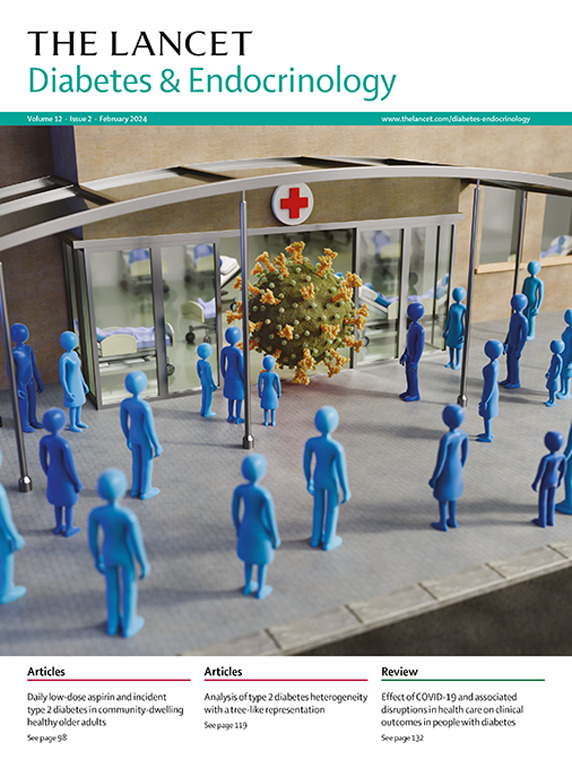Tirzepatide and muscle composition changes in people with type 2 diabetes (SURPASS-3 MRI): a post-hoc analysis of a randomised, open-label, parallel-group, phase 3 trial
IF 41.8
1区 医学
Q1 ENDOCRINOLOGY & METABOLISM
引用次数: 0
Abstract
Background
Substantial weight reduction is often associated with loss of muscle mass. Tirzepatide has been associated with significant reductions in body weight in type 2 diabetes trials and a beneficial effect on body fat distribution in the SURPASS-3 MRI substudy. This post-hoc exploratory analysis studied the association of tirzepatide treatment with changes in thigh muscle volume, muscle volume Z score, and muscle fat infiltration, and aimed to contextualise the results using longitudinal MRI data from UK Biobank participants.Methods
SURPASS-3 was a randomised, open-label, parallel-group, phase 3 trial. The multicentre (45 sites) and multinational (eight countries) MRI substudy of SURPASS-3 enrolled insulin-naive adults (aged ≥18 years) with type 2 diabetes who were on treatment with metformin with or without a sodium–glucose co-transporter-2 (SGLT-2) inhibitor, had an HbA1c of 7·0–10·5% (53–91 mmol/mol), a BMI of at least 25 kg/m2, and a fatty liver index of at least 60. Participants were randomly assigned (1:1:1:1) to receive subcutaneous injection once per week of tirzepatide (5, 10, or 15 mg), or subcutaneous injection once per day of titrated insulin degludec. Thigh muscle fat infiltration, muscle volume, and muscle volume Z score (invariant to sex, height, weight, and BMI) were quantified by MRI at baseline and week 52. In this post-hoc analysis, we assessed the differences between mean baseline and week 52 muscle composition values in the tirzepatide groups (pooled 5 mg, 10 mg, and 15 mg group, and per dose group) and insulin degludec group using paired t tests, and the differences in muscle composition changes with pooled tirzepatide versus insulin degludec via adjusted ANCOVA models. Observed changes in muscle fat infiltration, muscle volume, and muscle volume Z scores were compared using paired t tests to population-based estimates calculated from multiple linear regression models fitted to UK Biobank data (n=2942), capturing associations with change in body weight. Analyses were done by modified intention to treat, in the participants enrolled in the MRI substudy with a valid MRI scan at week 52. The SURPASS-3 clinical trial is registered with ClinicalTrials.gov, NCT03882970, and is complete.Findings
Participants were assessed for eligibility and recruited from April 1, 2019, to Nov 15, 2019. Among 502 participants assessed for eligibility to participate in the MRI substudy, 296 were enrolled, and 246 had a valid week 52 MRI scan and were included in the post-hoc analyses (tirzepatide 5 mg, n=63; tirzepatide 10 mg, n=60; tirzepatide 15 mg, n=67; insulin degludec, n=56; 147 [59·8%] male participants and 99 [40·2%] female participants). At baseline, overall mean age was 56·0 years (SD 9·9), median duration of type 2 diabetes was 6·7 years (IQR 3·7 to 10·7), mean HbA1c was 8·3% (SD 0·9), mean BMI was 33·4 kg/m2 (SD 4·8), and 76 (30·9%) were on an SGLT-2 inhibitor. Mean baseline muscle fat infiltration, muscle volume, and muscle volume Z scores were similar between the pooled tirzepatide group and insulin degludec group. For the pooled and individual tirzepatide dose groups, significant reductions were observed from baseline to week 52 in muscle fat infiltration (for pooled tirzepatide, mean change –0·36 percentage points [95% CI –0·48 to –0·25], p<0·0001), muscle volume (–0·64 L [95% CI –0·74 to –0·54], p<0·0001), and muscle volume Z score (–0·22 [95% CI –0·29 to –0·15], p<0·0001), which occurred in the context of significant weight reduction. Insulin degludec was associated with a modest and significant increase in bodyweight and muscle volume, but no significant change in the other variables. The changes in all three muscle composition variables with pooled tirzepatide were significantly different compared to those with insulin degludec. In tirzepatide-treated participants, observed muscle volume changes across all tirzepatide doses were similar to population-based estimated changes (for pooled tirzepatide, mean difference vs population-based estimate, –0·04 L [95% CI –0·11 to 0·03], p=0·22); whereas, observed reductions in muscle fat infiltration across all doses were significantly greater than population-based estimates (for pooled tirzepatide, mean difference –0·42 percentage points [95% CI –0·54 to –0·31], p<0·0001), and the observed reduction in muscle volume Z score with tirzepatide 15 mg was significantly greater than the population-based estimate (mean difference –0·18 [95% CI –0·29 to –0·07], p=0·0016).Interpretation
In the SURPASS-3 MRI substudy, in the context of significant improvements in bodyweight and fat distribution, tirzepatide treatment was associated with potentially favourable changes in muscle fat infiltration and reductions in muscle volume broadly in accordance with the general association between changes in muscle volume and bodyweight. The present findings provide additional information on the potential effect of tirzepatide on muscle health that might help health-care providers when deciding among treatment options for individual patients.Funding
Eli Lilly and Company.替西肽和2型糖尿病患者肌肉成分的变化(SURPASS-3 MRI):一项随机、开放标签、平行组、3期试验的事后分析
背景:大量的体重减轻通常与肌肉质量的减少有关。在2型糖尿病试验中,替西帕肽与体重显著降低有关,在SURPASS-3 MRI亚研究中,替西帕肽对体脂分布有有益影响。这项事后探索性分析研究了替西肽治疗与大腿肌肉体积、肌肉体积Z评分和肌肉脂肪浸润变化的关系,旨在利用英国生物银行参与者的纵向MRI数据将结果背景化。方法ssurpass -3是一项随机、开放标签、平行组的3期试验。surpass3的多中心(45个地点)和多国(8个国家)MRI亚组研究纳入了接受二甲双胍治疗(含或不含钠-葡萄糖共转运体-2 (SGLT-2)抑制剂)的2型糖尿病患者(年龄≥18岁),HbA1c为7.0 - 10.5% (53-91 mmol/mol), BMI至少为25 kg/m2,脂肪肝指数至少为60。参与者被随机分配(1:1:1:1:1)接受每周一次的替西帕肽(5、10或15毫克)皮下注射,或每天皮下注射1次滴定的去葡萄糖酸胰岛素。在基线和第52周通过MRI量化大腿肌肉脂肪浸润、肌肉体积和肌肉体积Z评分(与性别、身高、体重和BMI无关)。在这项事后分析中,我们使用配对t检验评估了替西肽组(合并5mg、10mg和15mg组以及单剂量组)和去葡糖苷胰岛素组的平均基线和第52周肌肉组成值的差异,并通过调整的ANCOVA模型评估了合并替西肽与去葡糖苷胰岛素的肌肉组成变化差异。使用配对t检验将观察到的肌肉脂肪浸润、肌肉体积和肌肉体积Z分数的变化与基于人群的估计值进行比较,这些估计值是通过拟合UK Biobank数据(n=2942)的多元线性回归模型计算得出的,捕获了与体重变化的关联。在第52周进行有效MRI扫描的MRI亚研究参与者中,通过修改治疗意向进行分析。SURPASS-3临床试验已在ClinicalTrials.gov注册,注册号为NCT03882970,并且已经完成。在2019年4月1日至2019年11月15日期间,对参与者进行了资格评估和招募。在502名被评估有资格参加MRI亚研究的参与者中,296人入组,246人进行了有效的第52周MRI扫描,并被纳入事后分析(替西帕肽5 mg, n=63;替西帕肽10 mg, n=60;替西帕肽15 mg, n=67;葡糖苷胰岛素,n=56;男性147例[59.8%],女性99例[40.2%])。基线时,总体平均年龄为56.0岁(SD为9.9),2型糖尿病的中位病程为6.7年(IQR为3.7至10.7),平均HbA1c为8.3% (SD为0.9),平均BMI为33.4 kg/m2 (SD为4.8),76人(30.9%)服用SGLT-2抑制剂。平均基线肌肉脂肪浸润、肌肉体积和肌肉体积Z评分在联合替西肽组和去葡糖苷胰岛素组之间相似。对于联合用药组和单独用药组,从基线到第52周,肌肉脂肪浸润(联合用药组,平均变化- 0.36个百分点[95% CI - 0.48至- 0.25],p< 0.0001)、肌肉体积(- 0.64 L [95% CI - 0.74至- 0.54],p< 0.0001)和肌肉体积Z评分(- 0.22 [95% CI - 0.29至- 0.15],p< 0.0001)均显著降低,这是在体重显著减轻的情况下发生的。降糖糖胰岛素与体重和肌肉量的适度显著增加有关,但在其他变量上没有显著变化。与胰岛素组相比,混合替西肽组所有三个肌肉成分变量的变化都有显著差异。在替西肽治疗的参与者中,观察到的肌肉体积变化与基于人群的估计变化相似(对于合并的替西肽,与基于人群的估计的平均差异为- 0.04 L [95% CI - 0.11至0.03],p= 0.22);然而,在所有剂量下观察到的肌肉脂肪浸润减少显著大于基于人群的估计(对于合并替西帕肽,平均差异为- 0.42个百分点[95% CI - 0.54至- 0.31],p= 0.0001),并且观察到的替西帕肽15 mg肌肉体积Z评分减少显著大于基于人群的估计(平均差异为- 0.18 [95% CI - 0.29至- 0.07],p= 0.0016)。在SURPASS-3 MRI亚研究中,在体重和脂肪分布显著改善的背景下,替西帕肽治疗与肌肉脂肪浸润的潜在有利变化和肌肉体积的减少有关,这与肌肉体积变化与体重之间的一般关联大致一致。 目前的研究结果为替西肽对肌肉健康的潜在影响提供了额外的信息,这可能有助于卫生保健提供者在决定个体患者的治疗方案时。资助礼来公司。
本文章由计算机程序翻译,如有差异,请以英文原文为准。
求助全文
约1分钟内获得全文
求助全文
来源期刊

The Lancet Diabetes & Endocrinology
ENDOCRINOLOGY & METABOLISM-
CiteScore
61.50
自引率
1.60%
发文量
371
期刊介绍:
The Lancet Diabetes & Endocrinology, an independent journal with a global perspective and strong clinical focus, features original clinical research, expert reviews, news, and opinion pieces in each monthly issue. Covering topics like diabetes, obesity, nutrition, and more, the journal provides insights into clinical advances and practice-changing research worldwide. It welcomes original research advocating change or shedding light on clinical practice, as well as informative reviews on related topics, especially those with global health importance and relevance to low-income and middle-income countries. The journal publishes various content types, including Articles, Reviews, Comments, Correspondence, Health Policy, and Personal Views, along with Series and Commissions aiming to drive positive change in clinical practice and health policy in diabetes and endocrinology.
 求助内容:
求助内容: 应助结果提醒方式:
应助结果提醒方式:


